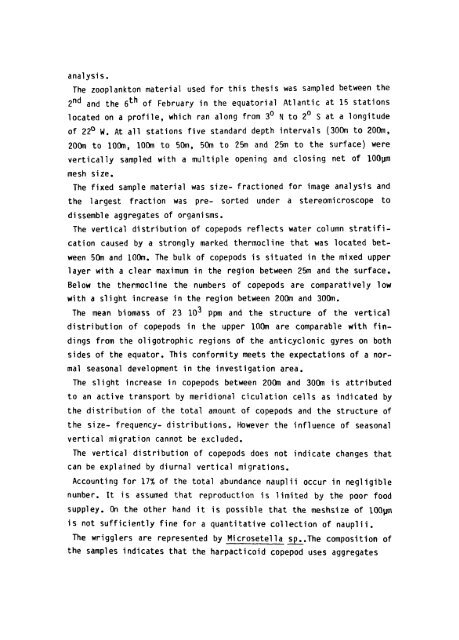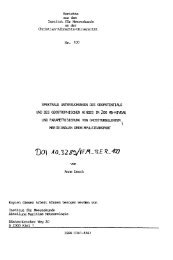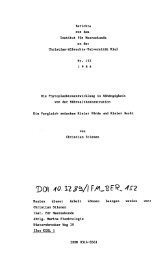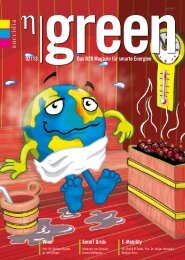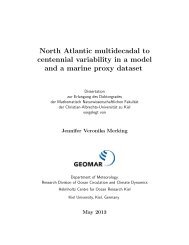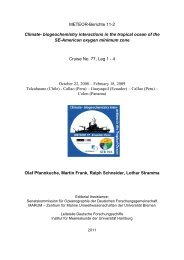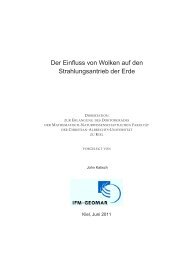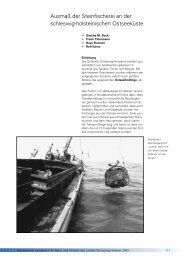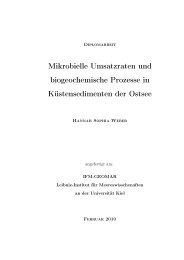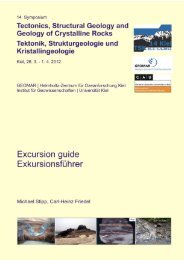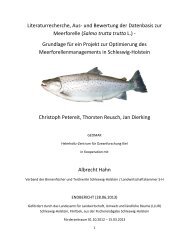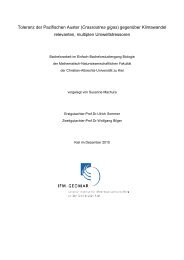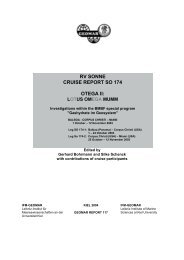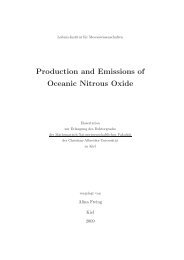Download (3148Kb) - OceanRep
Download (3148Kb) - OceanRep
Download (3148Kb) - OceanRep
Erfolgreiche ePaper selbst erstellen
Machen Sie aus Ihren PDF Publikationen ein blätterbares Flipbook mit unserer einzigartigen Google optimierten e-Paper Software.
analysis.<br />
The zooplankton material used for this thesis was sampled between the<br />
2nd and the 6th of February in the equatorial Atlantic at 15 stations<br />
located on a profile, which ran along from 3° N to 2° S at a longitude<br />
of 22° W. At all stations five standard depth intervals (300m to 200m,<br />
200m to 100m, 100m to 50m, 50m to 25m and 25m to the surface) were<br />
vertically sampled with a multiple opening and closing net of lOOym<br />
mesh size.<br />
The fixed sample material was size- fractioned for image analysis and<br />
the largest fraction was pre- sorted under a stereomicroscope to<br />
dissemble aggregates of organisms.<br />
The vertical distribution of copepods reflects water column stratification<br />
caused by a strongly marked thermocline that was located between<br />
50m and 100m. The bulk of copepods is situated in the mixed upper<br />
layer with a clear maximum in the region between 25m and the surface.<br />
Below the thermocline the numbers of copepods are comparatively low<br />
with a slight increase in the region between 200m and 300m.<br />
The mean biomass of 23 10^ ppm and the structure of the vertical<br />
distribution of copepods in the upper 100m are comparable with findings<br />
from the oligotrophic regions of the anti cyclonic gyres on both<br />
sides of the equator. This conformity meets the expectations of a normal<br />
seasonal development in the investigation area.<br />
The slight increase in copepods between 200m and 300m is attributed<br />
to an active transport by meridional ciculation cells as indicated by<br />
the distribution of the total amount of copepods and the structure of<br />
the size- frequency- distributions. However the influence of seasonal<br />
vertical migration cannot be excluded.<br />
The vertical distribution of copepods does not indicate changes that<br />
can be explained by diurnal vertical migrations.<br />
Accounting for 17% of the total abundance nauplii occur in negligible<br />
number. It is assumed that reproduction is limited by the poor food<br />
suppley. On the other hand it is possible that the meshsize of lOOyra<br />
is not sufficiently fine for a quantitative collection of nauplii.<br />
The wrigglers are represented by Hicrosetella sp..The composition of<br />
the samples indicates that the harpacticoid copepod uses aggregates


